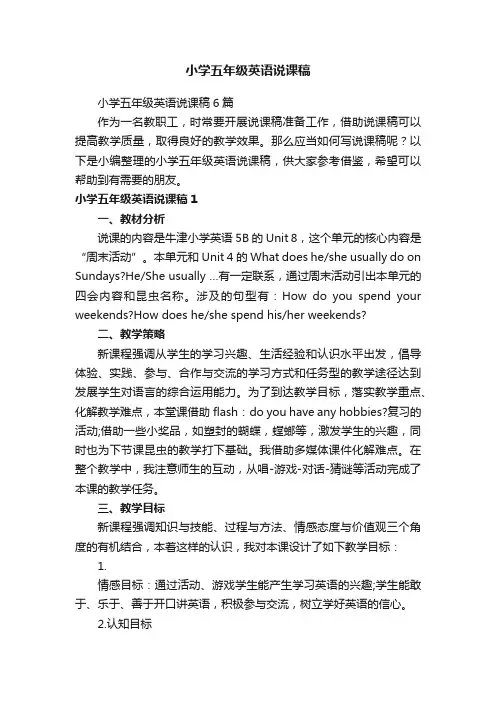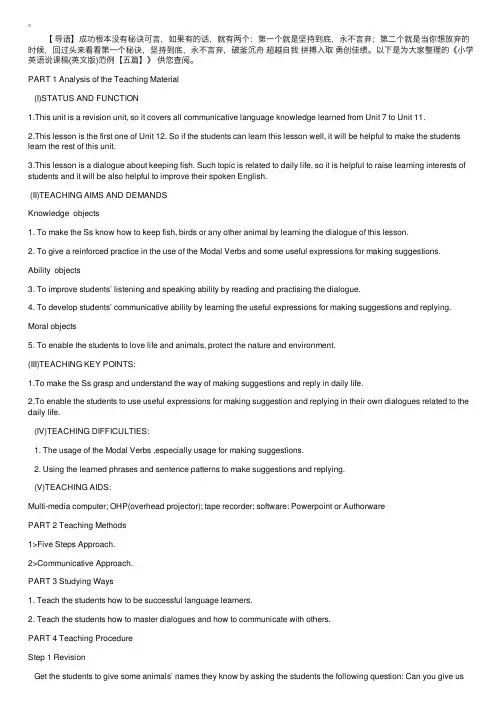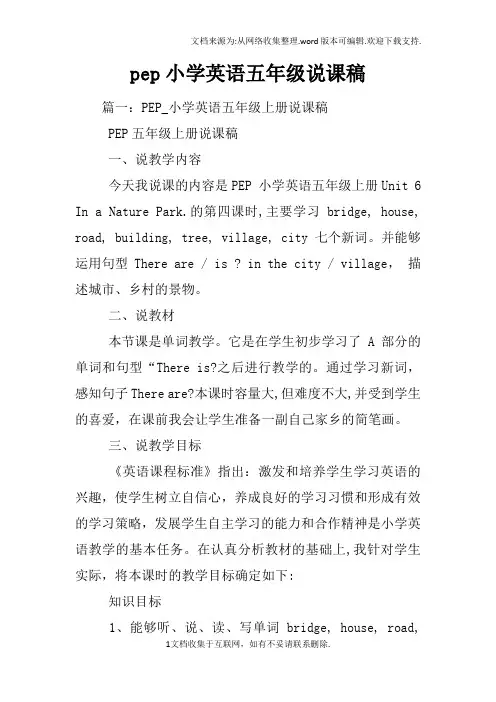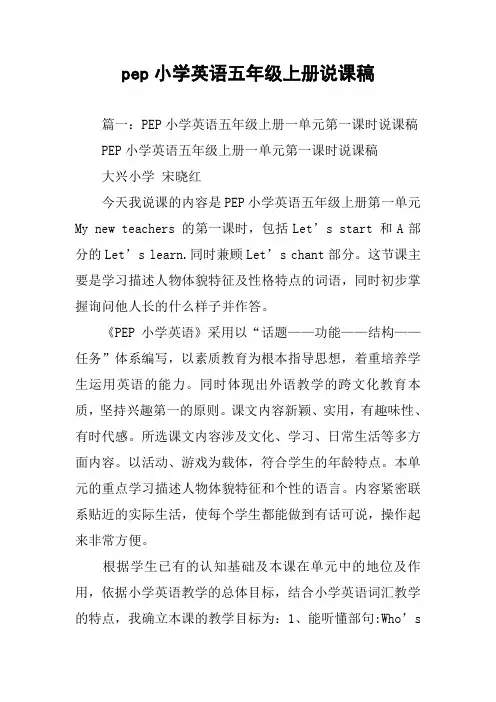小学五年级英语说课稿精选最新范文
五年级英语上册的说课稿6篇

五年级英语上册的说课稿6篇五年级英语上册的说课稿6篇教师需要建立完善的教学评价体系,及时了解学生的学习情况,及时调整教学策略,提高教学质量。
下面是小编为大家整理的五年级英语上册的说课稿,如果大家喜欢可以分享给身边的朋友。
五年级英语上册的说课稿【篇1】教学目标:知识与技能目标:1、学生能过灵活掌握有关做家务的动词短语并能应用到日常对话中。
2、掌握祈使句的构成方法及其答语。
情感目标:1、如何有礼貌地请求别人帮助自己做某件事。
2、能够通过活动培养学生主动做家务的意识和养成勤劳的好习惯。
教学重点:1、本课所有动词短语的正确发音和使用。
2、能较熟练地应用动词短语构成的祈使句。
教学难点:每个学生都能掌握所授内容,做好能听。
会说。
能读。
教具准备:1、PPT。
2、单词卡片。
3、小礼品。
教学过程:1、日常口语会话展示T:Hello,boys and girls。
How are you today?S:I am fine,thanks。
And you?T:I am fine,too。
2、游戏“摸鼻子”3、教授新课①出示make the bed图片。
T:Class,look at the picture。
What is he doing?Ps:…T:He is making the bed。
(出示短语,教读,注意确保学生读音准确无误)带读几遍之后,随即快速的抽取部分同学进行检查。
②以下四个短语与上述方法相同。
③教读。
④集体齐读短语。
⑤使用地雷游戏进行教读。
⑥教授手持卡片,每个小组读一个短语,3—5次。
比赛哪个组读得准确又整齐。
⑧操练短语。
采用boys PK girls的游戏方法。
抽男。
女生各两名读短语,给胜利的一方画笑脸,输的一方画哭脸。
4、教授句型①出示对话图片,帮助学生理解并运用新句型。
②教读。
③带动学生,用本课所学单词进行替换练习。
④T:Class,do you help your mother do housework?Now,I am your mother。
小学五年级英语说课稿6篇

小学五年级英语说课稿小学五年级英语说课稿6篇作为一名教职工,时常要开展说课稿准备工作,借助说课稿可以提高教学质量,取得良好的教学效果。
那么应当如何写说课稿呢?以下是小编整理的小学五年级英语说课稿,供大家参考借鉴,希望可以帮助到有需要的朋友。
小学五年级英语说课稿1一、教材分析说课的内容是牛津小学英语5B的Unit 8,这个单元的核心内容是“周末活动”。
本单元和Unit 4的What does he/she usually do on Sundays?He/She usually …有一定联系,通过周末活动引出本单元的四会内容和昆虫名称。
涉及的句型有:How do you spend your weekends?How does he/she spend his/her weekends?二、教学策略新课程强调从学生的学习兴趣、生活经验和认识水平出发,倡导体验、实践、参与、合作与交流的学习方式和任务型的教学途径达到发展学生对语言的综合运用能力。
为了到达教学目标,落实教学重点、化解教学难点,本堂课借助flash:do you have any hobbies?复习的活动;借助一些小奖品,如塑封的蝴蝶,螳螂等,激发学生的兴趣,同时也为下节课昆虫的教学打下基础。
我借助多媒体课件化解难点。
在整个教学中,我注意师生的互动,从唱-游戏-对话-猜谜等活动完成了本课的教学任务。
三、教学目标新课程强调知识与技能、过程与方法、情感态度与价值观三个角度的有机结合,本着这样的认识,我对本课设计了如下教学目标:1.情感目标:通过活动、游戏学生能产生学习英语的兴趣;学生能敢于、乐于、善于开口讲英语,积极参与交流,树立学好英语的信心。
2.认知目标(1)、四会掌握词组:at the weekends learn from三会词组of course catch insects watch cartoons等以前学过的词组。
(2)、句型:How do you spend your weekends?I oftenHow does he spend his weekends?He often…How does she spends her weekends?She often…(3)、能听读课文并理解熟读。
小学英语说课稿(英文版)范例【五篇】

【导语】成功根本没有秘诀可⾔,如果有的话,就有两个:第⼀个就是坚持到底,永不⾔弃;第⼆个就是当你想放弃的时候,回过头来看看第⼀个秘诀,坚持到底,永不⾔弃,破釜沉⾈超越⾃我拼搏⼊取勇创佳绩。
以下是为⼤家整理的《⼩学英语说课稿(英⽂版)范例【五篇】》供您查阅。
PART 1 Analysis of the Teaching Material(I)STATUS AND FUNCTION1.This unit is a revision unit, so it covers all communicative language knowledge learned from Unit 7 to Unit 11.2.This lesson is the first one of Unit 12. So if the students can learn this lesson well, it will be helpful to make the students learn the rest of this unit.3.This lesson is a dialogue about keeping fish. Such topic is related to daily life, so it is helpful to raise learning interests of students and it will be also helpful to improve their spoken English.(II)TEACHING AIMS AND DEMANDSKnowledge objects1. To make the Ss know how to keep fish, birds or any other animal by learning the dialogue of this lesson.2. To give a reinforced practice in the use of the Modal Verbs and some useful expressions for making suggestions.Ability objects3. To improve students’ listening and speaking ability by reading and practising the dialogue.4. To develop students’ communicative ability by learning the useful expressions for making suggestions and replying. Moral objects5. To enable the students to love life and animals, protect the nature and environment.(III)TEACHING KEY POINTS:1.To make the Ss grasp and understand the way of making suggestions and reply in daily life.2.To enable the students to use useful expressions for making suggestion and replying in their own dialogues related to the daily life.(IV)TEACHING DIFFICULTIES:1. The usage of the Modal Verbs ,especially usage for making suggestions.2. Using the learned phrases and sentence patterns to make suggestions and replying.(V)TEACHING AIDS:Multi-media computer; OHP(overhead projector); tape recorder; software: Powerpoint or AuthorwarePART 2 Teaching Methods1>Five Steps Approach.2>Communicative Approach.PART 3 Studying Ways1. Teach the students how to be successful language learners.2. Teach the students how to master dialogues and how to communicate with others.PART 4 Teaching ProcedureStep 1 RevisionGet the students to give some animals’ names they know by asking the students the following question: Can you give ussome names of different animals you know? This step is employed to revise the words related the animals. At the same time draw the students’ attention to the topic about animals.Step 2 Lead-inSign to the students to be quiet and close their books. Then start a free talk with the students. Use computer to show some pictures of different pets, such as dogs, cats etc. Ask the students several questions about raising pets. These questions are employed to warm up the students and raise the interests of the students to speak English in class on the topics they like and familiar with.Good morning, everyone!Today, I’ll say something about Unit 9 Part A in Book 4 of Oxford English.Background on the reformation of curriculum, this book can connect the life and act, emphasize the interest and experience of the Ss, the pictures are active and vivid. Grade four is the initial stage of English learning, so it stresses on the emotion of the Ss, creates a well beginning for the Ss. This Unit has 7 parts, we’ll learn Part A mainly, it embodies the repeating characterize. Review the learned language points “Where’s…”and the new language points will be represented in the following units. So this unit forms connecting links with a special meaning in this book.The content of this period is to use “Where’s\are…” to determine the place. And according to the contents and the fact of the Ss, I establish the following three teaching aims of this period:The first one: students can listen, read, say and spell the following words: a glass, a fridge, an egg, bread and a table.The second one: students can listen, read, say and write the following daily expressions: What’s for breakfast?Have some juice then.The third one: students can listen, read, say and write the following sentence patterns: Where’s\Where are the\my…It’s \They’re…There’s no …in \on \near…I think the most difficult point of this period is to make sure the students can use the patterns “Where’s\Where are…and There is no …in\on\near…” in their daily life correctly.And I will use some pictures, words and sentence cards, a tape recorder and the multi-media computer to help me achieve the aims.The task-based method, communicated method, group cooperate method will be used in this period.To accomplish the aims, I design the following steps:Step 1 Songs and the game arousers the emotion.In order to attract the Ss’ attention and construct an atmosphere of learning English, I let the students sing some English songs and play the game “Simon says”. At the same time the game can review the prep, serve the knowledge as foil and consist the appearance of the knowledge.Step 2 Change class to life, happy to say.The substance of language is communication and the environment of communication is life. So when I present the sentence pattern “What’s for breakfast?” I first show a clock to elicit the time for breakfast, teach the sentence. Then show my own photo of having breakfast, Ss ask and guess. In this way I can attract Ss’ attention, encourage Ss to ask Qs with the new knowledge.Most of the Ss have learnt the sentence pattern: Where’s…? so I design a task for Ss to help Helen find the food and drinks for breakfast, and teach the new language points: Where are…?They’re … Meanwhile stick the sentences on the Bb.After some practice by asking and answering, I present the next language points:There’s no …in\on\near…Have …then.And I will stick these sentence patterns on the Bb. Finally I’ll let the Ss do pair works to consolidate them.Step 3 Listen to the tape and Ss imitate to read and say.As the new reformation of curriculum, emphasized the traditional class attach importance to the mechanical teaching, neglect the experience and participation, for example, the five-step method. So in this lesson, after presentation, I ask Ss to listen to the tape with three Qs, read in different roles and in pairs, then try to recite the text.Step 4 Ss be the main body, T makes a guider.In class, Ss play as a host, and the T makes an influence on guiding, help Ss to act the learnt dialogue, it can stress the position of the Ss, and arouse their interest.Then I show a carton with no voice, ask Ss to make a dialogue in pairs.There are lots of ways to consolidate the new knowledge. Playing game is a good way. So according to the physiology of Ss, I hold a group competition during the game, ask Ss to finish the blanks. In this way can develop Ss’ good habits and achieve the aim of mastering the learned knowledge in situation.Step 5 Change class to life, learn by themselves.Is this the end of the class? I don’t think so. If there is an end, I think it should be in the life. So I extend this class, encourage Ss to use the learned to communicate with each other in their life.In a word, the whole period is based on tasks, which are designed from easy steps to steps that are challenging. When the Ss are carting out the tasks, they can acquire information, knowledge, and have their ability and skills trained.Thank you!。
pep小学英语五年级说课稿

pep小学英语五年级说课稿篇一:PEP_小学英语五年级上册说课稿PEP五年级上册说课稿一、说教学内容今天我说课的内容是PEP 小学英语五年级上册Unit 6 In a Nature Park.的第四课时,主要学习bridge, house, road, building, tree, village, city七个新词。
并能够运用句型There are / is ? in the city / village,描述城市、乡村的景物。
二、说教材本节课是单词教学。
它是在学生初步学习了A部分的单词和句型“There is?之后进行教学的。
通过学习新词,感知句子There are?本课时容量大,但难度不大,并受到学生的喜爱,在课前我会让学生准备一副自己家乡的简笔画。
三、说教学目标《英语课程标准》指出:激发和培养学生学习英语的兴趣,使学生树立自信心,养成良好的学习习惯和形成有效的学习策略,发展学生自主学习的能力和合作精神是小学英语教学的基本任务。
在认真分析教材的基础上,我针对学生实际,将本课时的教学目标确定如下:知识目标1、能够听、说、读、写单词bridge, house, road,building, tree.2、能够听、说、认读单词city, village能力目标能够运用句型There are / is ? in the city / village,描述城市、乡村的景物。
情感目标培养学生热爱家乡,热爱环境的情感。
四、说教学重点1、掌握Let’s learn中的七个有关自然景物的单词bridge, house, road, building, tree, village, city ,其中前五个单词要求听、说、读、写四方面掌握。
2、在情景中理解单词的同时掌握句型There is / are? ,能恰当地用此句型简单描述城市和村庄的景物There are ? in the city / village. ,结合句型教师引导学生替换单词,描述周围事物,如:教室、校园等,从而进一步运用句型。
pep小学英语五年级上册说课稿

在课前我播放本课时需要听懂、学会的歌曲“My new teachers”,让学生初步感知本单元的新语言。接着,再放第2页中Let’s chant的录音,让学生听歌谣猜猜本单元的课题,激发学生对新学期第一单元英语学习的兴趣。然后再播放三年级下册第六单元中的Let’s do ,师生一起边说边做动作:tall, tall, tall, Make yourself tall; short, short, short , Make yourself short. Big, big, big, Make your eyes big; Long , long , long, Make your arms long…复习以前曾经学过的有关人物体貌特征的形容词。让学生对本课的主要内容有个初步印象。
根据学生已有的认知基础及本课在单元中的地位及作用,依据小学英语教学的总体目标,结合小学英语词汇教学的特点,我确立本课的教学目标为:1、能听懂部句:Who’syour art teacherWhat’s he like并能正确作答。2、能够听、说、读、写单词:old, short, thin , tall, strong. 并能一上下文中理解其意思。 3、能够听懂指示语,并按照指令完成Let’s find out 中的简单任务,找出正确的画面。4、能够听懂、会唱歌曲“My new teachers”. 本课时的教学重点是Let’s learn 部分的单词:old , short, thin, tall, strong, young, funny, kind.要求学生在学习过程中能结合所给句型替换关键词,在情境中学习新单词,并逐步学会听、说、读、写单词:old, short, thin , tall, strong.
小学五年级英语说课稿【三篇】

【导语】海阔凭你跃,天⾼任你飞。
愿你信⼼满满,尽展聪明才智;妙笔⽣花,谱下锦绣第⼏篇。
学习的敌⼈是⾃⼰的知⾜,要使⾃⼰学⼀点东西,必需从不⾃满开始。
以下是为⼤家整理的《⼩学五年级英语说课稿【三篇】》供您查阅。
【第⼀篇:Halloween】我要说的是江苏⽜津英语5AUnit4 Halloween A 部分的内容。
本单元的核⼼内容是万圣节万晚会的准备⼯作,本部分提供了两个场景,第⼀个场景是在客厅⾥,Ben⼀家⼈在讨论万圣节晚会的所需物品;第⼆个场景是在商店⾥妈妈带着Ben和Ron 在购买商定的所需物品。
本课所涉及到的节⽇Halloween对学⽣来说⽐较陌⽣,所以⽼师可以准备⼀些相关资料,⽤多媒体展⽰,既能调动学⽣的学习兴趣,⼜能有这些知识引导到本课的学习场景中来。
本课可采取让学⽣合作学习的⽅法,通过⼩组对话操练,⼩组讨论,⼩组表演等学习⽅法,让学⽣学会运⽤本课的功能句型和会说、表演本课的场景对话。
教学⽬标 语⾔知识⽬标 1. 能听得懂、会说、会读和会拼写单词need, a vase, mask, horse。
2. 能听得懂、会说、会读单词Halloween, else, tomorrow, pumpkin, lantern, change。
3. 能听得懂、会读、会说句型What do you need? We need… What else do you need? We need… How much are they? They're …yuan. Here's your change. 语⾔能⼒⽬标 1.能根据情景和图⽚说出单词。
2.会读句型,并能⽤句型设置情景,⾃编对话。
情感态度⽬标 1.在多元化的学习过程中,⾃主学习。
2.在任务型学习活动中能灵活应变,学会创造。
3.在⼩组活动中,展⽰各成员的掌握运⽤语⾔的综合能⼒。
⽂化意识⽬标 了解万圣节的由来,西⽅国家过万圣节的常备物品,⼩孩⼦们怎样过万圣节的。
五年级英语万能说课稿
五年级英语万能说课稿尊敬的各位老师,亲爱的同学们:大家好!今天我要为大家说课的内容是五年级英语课程。
在我们的课程中,我们将通过丰富多彩的教学活动,帮助学生巩固和扩展他们的英语知识,提高他们的语言运用能力。
接下来,我将从教材分析、教学目标、教学方法、教学过程以及评价与反思五个方面进行详细的阐述。
一、教材分析本节课我们使用的是《新标准英语》五年级下册的教材。
本单元的主题是“My Day”,通过这个主题,我们将学习如何用英语描述日常生活中的活动和时间安排。
教材内容涵盖了词汇、语法、对话和阅读等多个方面,旨在全面提升学生的英语听说读写能力。
二、教学目标1. 知识与技能目标:学生能够掌握描述日常活动的词汇和表达方式,能够使用一般现在时描述自己的日常活动,并能够听懂和朗读相关的短文。
2. 过程与方法目标:通过小组合作和角色扮演等活动,培养学生的合作能力和交际能力。
3. 情感态度与价值观目标:激发学生学习英语的兴趣,培养学生合理安排时间的良好习惯,以及积极参与课堂活动的态度。
三、教学方法1. 任务型教学法:通过设计贴近学生生活的任务,让学生在完成任务的过程中学习和使用英语。
2. 合作学习法:鼓励学生分组合作,通过交流和讨论,共同完成学习任务。
3. 情景教学法:创设真实或模拟的情景,让学生在情景中学习和运用英语。
四、教学过程1. 导入(Warm-up):通过播放一段关于日常生活的英文视频,引起学生的兴趣,并引导学生谈论自己的一天是如何安排的。
2. 新课呈现(Presentation):教师展示与日常生活活动相关的图片和词汇卡片,带领学生学习新单词,并用一般现在时介绍自己的日常活动。
3. 操练(Practice):学生两人一组,用所学词汇和句型进行对话练习,描述自己和对方的一天。
4. 情景模拟(Role-play):创设一个情景,如“介绍你的周末计划”,让学生在小组内进行角色扮演,运用所学语言进行交流。
5. 阅读(Reading):教师引导学生阅读一篇关于日常活动的短文,并提出一些问题,让学生在阅读中寻找答案。
小学五年级上学期英语说课稿范本三篇
小学五年级上学期英语说课稿范本三篇我说课的内容是小学英语五年级上册PEP UNIT 4 PART B 的第二个课时,包括Let‘s try Let 's talk Let ‘s play教材分析1. 教学内容本课主要学习相关家务劳动的表述,主要句型有:Can you ……? Yes ,I can No ,I can 't . 本课时的绝大部分动词词组在四年级上下册中都已出现过。
如:Water the flowers ,sweep the floor ,set the table.2. 教学目标。
(1)语言技能与知识目标通过本课的学习,能够询问别人能做什么家务。
如:Can youset the table ?(2)使用水平目标会用Can you…?语句询问并作出肯定或否定回答。
(3)情感、策略、文化目标A、情感态度:注重培养学生乐于助人的优秀品质。
B、学习策略:注重与他人合作,共同完成学习任务的合作精神。
3. 教学重、难点。
重点:句型Can you…?并作出肯定或否定回答。
难点:句子I‘d like to have a try . 以及在实际情景中准确使用所学对话。
4. 说教学过程STEP1 Practise Oral EnglishT:Who's your math teacher ?S:Miss ShenT:What‘s your favourite food ?S:My favourite food is chicken .STEP2 Let's try(1)、先请同学们听一遍录音,并完成连线。
(2)、再听一遍,请两名同学上来完成连线。
(3)、师生互问,教师指着sarah 的图像问What can she do ?指着吴义凡的头像问What can he do ?然后指着陈杰的头像问What can she do ?引出Let‘s talk 。
STEP3 Let's talk(1)请同学们自己阅读,然后找出答案。
小学英语五年级说课稿
小学英语五年级说课稿小学英语五年级说课稿1敬重的各位评委、老师!你们好!我叫xxx。
今日我说课的内容是人教版小学英语五年级上册Unit 1 《My new teachers 》第一课时。
针对这部分内容我将从教材分析、教法与学法、教学过程、板书设计这几个方面来进行说课。
一、教材分析:我说课的这一课时其主要内容是教授一些描述人物外貌的单词 for example : young old tall short strong thin 等以及询问人物外貌及其回答的句子“Who is your art teacher ?”“What’s he like ?”“He is tall and thin.”(来自: 小龙文档网:pep小学英语五年级说课稿)本课是交际型的训练课,我借助任务型教学采纳多样化的教学手段将听、说、读、演溶为一体,激发学生的爱好和愿望。
依据新课程目标的要求及我对教材的理解,结合对小学生的认知水平,我设置如下几个教学目标:(1)学问目标:使学生能够正确驾驭strong thin 等单词的正确发音,能听、说、读、写单词及重点句型(2)实力目标:使学生能够依据指令做动作,能在图片或场景下进行简洁的英语沟通和表演(3)情感目标:通过本课的学习能使学生有爱好听、说英语,敢于开口,乐于仿照,在激励性的评价中树立信念,在小组活动中主动参加合作充分利用教材和多媒体教学主动与他人沟通。
结合教学目标的要求我把本课的教学重点设置为:驾驭新单词的正确发音,了解描述人物的句子: “Who is your new teacher ?”“He is tall.”等。
难点是能在情境中进行仿照,创新。
二、说教法与学法依据小学生的好动、爱表现的特点。
在教学过程中,我主要实行全身反应法、PPT教学协助法、小组竞争法、激励法、嬉戏法相结合的方法,激发小学生学习英语的爱好,提高教学质量。
三、教学过程我将从以下几个环节来突破我的教学重难点。
五年级英语说课稿精彩范文2篇
五年级英语说课稿精彩范文五年级英语说课稿1一说教材:新英语课程标准指出,基础教育阶段英语课程的总体目标是培养学生的综合语言运用能力。
而综合语言运用能力又以学生语言技能、语言知识、情感态度、学习策略和文化意识五个方面的综合素养为基础。
《新课标》倡导任务型教学模式,即让学生在教学活动中参与和完成真实的教学任务,从中体验学习的快乐。
因此我采用“任务——探究——创造”型教学方法,让学生在有趣,开放式的语言环境中,学会观察,思考,讨论和总结,在“用”中发展思维能力、创新意识和各种语言应用能力。
我说课的内容是第十一课的第一课时。
这是一节情景对话课,围绕“征询意见”这一日常用语展开。
在第三课中,学生已经能用“ would you like some…?”进行询问。
能听懂会说chicken,pop, milk, a sandwich。
本课时的教学内容为用“What would you like?”进行征询意见。
根据这一安排和学生的整体认识水平,从知识教学、能力培养等方面考虑,我确立本课时的教学目标为:1、知识目标:能听懂会说I'm hungry. What would you like?Yes, I'd like……2、能力目标:听懂会说hamburger、French fries、pizza、pop。
3、情感目标:能运用所学句型进行对话表演和口语交际,激发学生学习英语的兴趣,培养学生的英语学习能力。
4 本课时的教学重点是:能听懂会说 I'm hungry. What would you like? No, I'd like……听懂会说hamburger、French fries、pizza、pop。
教学难点是能用“What would you like?”征询别人意见以及hamburger, French fries的正确发音。
5 学情分析:由于学生已学过类似的对话,我打算以对话的形式讲授新知识。
- 1、下载文档前请自行甄别文档内容的完整性,平台不提供额外的编辑、内容补充、找答案等附加服务。
- 2、"仅部分预览"的文档,不可在线预览部分如存在完整性等问题,可反馈申请退款(可完整预览的文档不适用该条件!)。
- 3、如文档侵犯您的权益,请联系客服反馈,我们会尽快为您处理(人工客服工作时间:9:00-18:30)。
小学五年级英语说课稿精选最新范文小学五年级英语说课稿范文一:Havingagreattrip一、教材内容分析本课时的教学内容为新起点五年级下册第五单元教材第56-57页内容,即:Get ready, A Listen and tick, B Chant and say和C Let’s write. 在A部分,借助Get ready图和对话录音,情境化地呈现了本课的目标词:went to the beach, drank cold drinks, swam in the sea, ate ice-cream, went to the Stone Forest, bought some gifts, saw flowers, took pictures等短语;让学生通过看、听、选择等途径来感知并学习这些短语。
B部分通过歌谣帮助学生操练词汇并学习另外两个目标词,同时体会It was boring. 等句子在交际情境中的运用。
C部分是学生根据语境,使用恰当的词语填空。
二、学生情况分析五年级的学生在本套教材第八册的第三单元学习了Travel Plans学习了sea, ski, eat seafood, visit the Mogao Caves, West Lake, row a boat, the Great Wall, take photos等描述旅游景点名称及相关活动的单词和短语,学生能够用We can … 初步表达在风景名胜中所从事的相关活动。
这些为本节课的顺利开展打下了基础。
三、教学目标通过本节课的学习,学生能够达到以下目标:1. 能够听懂、会说went to the beach, drank cold drinks, swam in the sea, ate ice-cream, went to the Stone Forest, bought some gifts, saw flowers, took pictures等单词和短语,尝试借助拼读规律记忆它们,并能够根据语境选择恰当的单词形式填空。
2. 能够通过说唱歌谣,以及运用谈论过去旅游情况的功能句I went to (I)climbed … 等操练本单元的重点词汇。
3. 能够根据语境选择单词的恰当的形式填空。
四、教学重难点教学重点:能够听懂、会说went to the beach, drank cold drinks, swam in the sea, ate ice-cream, went to the Stone Forest, bought some gifts, saw flowers, took pictures等单词和短语,尝试借助拼读规律记忆它们,并能够根据语境选择恰当的单词形式填空。
教学难点:能够通过说唱歌谣,以及运用谈论过去旅游情况的功能句I went to (I)climbed … 等操练本单元的重点词汇。
五、教学步骤1. 热身(唱一唱)T: Good morning, boys and girls.Ss: Good morning, Miss Fan.T: Look at these beautiful pictures. Where is it? (点击课件,出现三亚风景图片) Ss: Sanya.T: Great! Is it a beautiful place?Ss: Yes.T: Did you go to Sanya?Ss: Yes. / No.T: When did you go Sanya?S: I went there …T: __ went to Sanya. Our friend——Bill went to Sanya, too. What did Bill do there? Let’s have a look.设计意图:开门见山,直入正题。
2. 学习(学一学,练一练)(1)单词教学①教学went to the beachT: Where is it? (点击课件,出现海滩)S: 海边/沙滩T: Yes. It’s beach. (点击课件,出现beach 单词) How to read the word? (出现teach, each)学生读单词,根据旧单词试着拼读新单词。
设计意图:用旧单词学习新单词的方法,培养学生学习能力。
T: /bi:t?/S: /bi:t?/T: Do you like the beach?S: Yes.T: What can you see there?S: I can see the sea, the sand and …T: Is it beautiful?Ss: Yes.T: It’s so beautiful, so Bill went to the beach. (点击课件,出现went) went to the beachSs: went to the beachT: Look at the picture. Bill went to the beach. Who else went to the beach?Ss: Bill’s parents.T: You are right. You should go to the beach with your parents.设计意图:在学习的过程中适时进行安全教育是必须的。
T: Who went to the beach in our class?S: Me.T: Bill went to the beach. __ went to the beach, too. What did Bill do there?设计意图:在说周围同学的经历的时候,同时也是巩固新学的动词过去式。
②教学swam in the seaT: The sea is blue. It’s hot. Bill swam in the sea. /sw?m/S: /sw?m/T: Bill ________. (教师引导学生说图)S: Bill swam in the sea.T: Did you swim in the sea, __?S: Yes.T: __ ____. (教师引导学生用学过的动词过去式短语说句子)S: __ swam in the sea.③教学drank cold drinksT: Bill swam in the sea half an hour. He was tired. What did he do then? Look! (点击课件)He ____. (教师引导学生说句子) Drank hot drinks?S: No.T: Bill drank cold drinks. /dr??k/S: /dr??k/T: Can you drink cold drink after exercises?S: No.T: Drinking cold drinks after exercising is not good for our body. You should drink warm water. Right?S: Yes.T: Did you drink cold drinks in last summer?Ss: Yes. / No.T: After Bill drank cold drinks, he swam in the sea again. He swam and swam. Half an hour, he was tired again. What did he do?④教学ate ice-creamT: Look! (点击课件) He ate ice- cream. /eit/S: /eit/T: What does a—e say?Ss: It says /ei/.T: OK. Was Bill right?S: No.T: What should he do?S: He should drink warm water.T: Clever.⑤教学went to the Forest StoneT: Bill went to Sanya. What about Lily? Where did Lily go? Look! (点击课件) Where is it?S: Kunming.T: Good job. Did Lily go to Kunming with her parents?S: No.T: Who?S: …T: Lily went to Kunming with her uncle’s family. Where did Lily visit? Look! (点击课件)Where is it?S: 石林T: the Stone ForestSs: the Stone ForestT: The Stone Forest is very beautiful. Lily went there. Who went there in our class?S: Me.T: What did you do there?S: … (教师帮助学生用过去式表达)⑥教学saw flowersT: Look! What are these?S: Flowers.T: Beautiful?S: Yes!T: Lily went to the Stone Forest. The flowers were there. Lily saw flowers. /s?:/ S: /s?:/T: I saw many flowers. Did you see flowers? (手指课件上面的花儿)S: Yes. I saw flowers.⑦教学took photosT: What did Lily do after seeing flowers? (点击课件,出现词组和旧单词) S: took photosT: You are so clever. Who took photos for Lily?S: Lily’s uncle.T: Good. Did you take photos when you had a trip?S: Yes.T: OK. We will talk about your photos.⑧教学bought some giftsT: When Lily’s trip was over, she went to a shop. What did she do? (点击课件) S: bought some giftsT: Right. What did she buy?S: She bought some gifts.T: Super.(2)Listen and tickT: Now open your book and turn to P57. Let’s listen and tick. Take out your pencils. (点击课件)学生听音,打勾,班内校正,及时评价。
